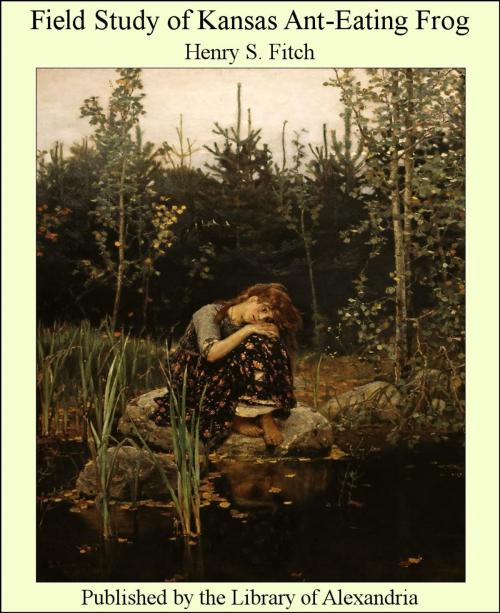Field Study of Kansas Ant-Eating Frog
Nonfiction, Religion & Spirituality, New Age, History, Fiction & Literature| Author: | Henry S. Fitch | ISBN: | 9781465526083 |
| Publisher: | Library of Alexandria | Publication: | March 8, 2015 |
| Imprint: | Language: | English |
| Author: | Henry S. Fitch |
| ISBN: | 9781465526083 |
| Publisher: | Library of Alexandria |
| Publication: | March 8, 2015 |
| Imprint: | |
| Language: | English |
The ant-eating frog is one of the smallest species of vertebrates on the University of Kansas Natural History Reservation, but individually it is one of the most numerous. The species is important in the over-all ecology; its biomass often exceeds that of larger species of vertebrates. Because of secretive and subterranean habits, however, its abundance and effects on community associates are largely obscured. The Reservation, where my field study was made, is the most northeastern section in Douglas County, Kansas, and is approximately 5½ miles north and 2½ miles east of the University campus at Lawrence. The locality represents one of the northernmost occurrences of the species, genus, and family. The family Microhylidae is a large one, and most of its representatives are specialized for a subterranean existence and a diet of termites or ants. The many subfamilies of microhylids all have distributions centering in the regions bordering the Indian Ocean, from South Africa and Madagascar to the East Indies, New Guinea, and Australia (Parker, 1934). Only one subfamily, the Microhylinae, is represented in the New World, where it has some 17 genera (de Carvalho, 1954) nearly all of which are tropical. G. olivacea, extending north into extreme southern Nebraska (Loomis, 1945: 211), ranges farther north than any Other American species. In the Old World only Kaloula borealis has a comparable northward distribution. Occurring in the vicinity of Peiping (Pope, 1931: 587), it reaches approximately the same latitude as does Gastrophryne in Nebraska. The great majority of microhylid genera and species are confined to the tropics. Nearly all ant-eating frogs seen on the Reservation have been caught and examined and individually marked. By November 1, 1954, 1215 individuals had been recorded with a total of 1472 captures. In the summer of 1950, Richard Freiburg studied this frog on the Reservation and his findings (1951) led to a better understanding of its natural history. The numbers of frogs studied by him however, were relatively small and the field work was limited to the one summer. The data now at hand, representing six consecutive years, 1949 through 1954, serve to supplement those obtained by Freiburg, corroborating and extending his conclusions in most instances, and also indicating that certain of his tentative conclusions need to be revised. While the present report was in preparation, Anderson (1954) published an excellent account of the ecology of the eastern species G. carolinensis in southern Louisiana. Anderson's findings concerning this closely related species in a much different environment have been especially valuable as a basis for comparison. The two species are basically similar in their habits and ecology but many minor differences are indicated. Some of these differences result from the differing environments where Anderson's study and my own were made and Others certainly result from innate genetic differences between the species
The ant-eating frog is one of the smallest species of vertebrates on the University of Kansas Natural History Reservation, but individually it is one of the most numerous. The species is important in the over-all ecology; its biomass often exceeds that of larger species of vertebrates. Because of secretive and subterranean habits, however, its abundance and effects on community associates are largely obscured. The Reservation, where my field study was made, is the most northeastern section in Douglas County, Kansas, and is approximately 5½ miles north and 2½ miles east of the University campus at Lawrence. The locality represents one of the northernmost occurrences of the species, genus, and family. The family Microhylidae is a large one, and most of its representatives are specialized for a subterranean existence and a diet of termites or ants. The many subfamilies of microhylids all have distributions centering in the regions bordering the Indian Ocean, from South Africa and Madagascar to the East Indies, New Guinea, and Australia (Parker, 1934). Only one subfamily, the Microhylinae, is represented in the New World, where it has some 17 genera (de Carvalho, 1954) nearly all of which are tropical. G. olivacea, extending north into extreme southern Nebraska (Loomis, 1945: 211), ranges farther north than any Other American species. In the Old World only Kaloula borealis has a comparable northward distribution. Occurring in the vicinity of Peiping (Pope, 1931: 587), it reaches approximately the same latitude as does Gastrophryne in Nebraska. The great majority of microhylid genera and species are confined to the tropics. Nearly all ant-eating frogs seen on the Reservation have been caught and examined and individually marked. By November 1, 1954, 1215 individuals had been recorded with a total of 1472 captures. In the summer of 1950, Richard Freiburg studied this frog on the Reservation and his findings (1951) led to a better understanding of its natural history. The numbers of frogs studied by him however, were relatively small and the field work was limited to the one summer. The data now at hand, representing six consecutive years, 1949 through 1954, serve to supplement those obtained by Freiburg, corroborating and extending his conclusions in most instances, and also indicating that certain of his tentative conclusions need to be revised. While the present report was in preparation, Anderson (1954) published an excellent account of the ecology of the eastern species G. carolinensis in southern Louisiana. Anderson's findings concerning this closely related species in a much different environment have been especially valuable as a basis for comparison. The two species are basically similar in their habits and ecology but many minor differences are indicated. Some of these differences result from the differing environments where Anderson's study and my own were made and Others certainly result from innate genetic differences between the species















